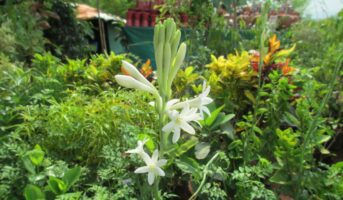Zinnia plant is a beautiful and eye-catching flower that is popular in gardens across the world. Its large and vibrant blooms come in a wide range of colours, making it a perfect choice for adding a splash of colour to any outdoor space. In addition to its beauty, the zinnia plant is low-maintenance and easy to grow. This article will discuss the different uses of the zinnia plant, how to grow and maintain it, and provide some helpful tips. Read on to learn more about this stunning flower and how you can make the most out of it in your garden.

Source: Pinterest
See also: Zinnia Elegans: How to grow and care for it?
Zinnia: Quick facts
| Kingdom | Plantae |
| Order | Asterales |
| Family | Asteraceae |
| Height | 12 to 18 inches tall |
| Native | United States, Mexico, and Central America |
| Benefits | Ornamental, Medicinal |
Zinnia: Physical description
Zinnia boasts lance-shaped leaves with a rough texture, while other varieties feature wider, smoother leaves. The flowers of zinnias come in various forms, including daisy-like, double, cactus-flowered, and dahlia-like. This flowering plant blooms continuously throughout the summer and often well into fall, with a lifespan in the garden ranging from 2 to 5 months. Zinnias thrive in hot summer temperatures as well as warm springs and autumns. Although they don’t require deadheading, performing this task can lead to a prolonged bloom period.
Zinnia: How to grow
- Zinnia seeds can be easily grown into healthy and vibrant plants. For best results, it’s recommended to plant the seeds once the soil temperature has risen and the risk of frost has passed.
- The seeds should be sown about 1/4 inch deep in well-draining soil with full sun exposure.
- If starting seeds indoors, it’s recommended to do so 4-6 weeks before the last expected frost date.
- For those who don’t have saved seeds, zinnia seedlings are widely available for purchase at garden centres, although the various options may be limited.

Source: Pinterest
Zinnia: Maintenance tips
- Planting and Soil Requirements: Zinnias should be planted in the spring. They are not particular about the type of soil they are planted in, but they do need adequate space between plants. For smaller varieties, leave at least 6 inches between plants, and for larger types, 12 to 18 inches is recommended for proper air circulation and to prevent diseases.
- When planting zinnia seeds, you can plant two or three seeds in each hole to increase your chances of success, but if multiple seedlings sprout. Remove the weaker ones after they have grown 2 to 3 inches and keep only the strongest ones.
- The soil should be well-draining and if it is poor, adding compost can help, but zinnias can grow in even poor soil. However, their roots cannot tolerate damp soil, as it can lead to fungal infections like powdery mildew. A neutral soil pH is ideal, but not required.
- Light: Zinnias should be planted in a location with full sun exposure for the most prolific blooms and to keep the leaves dry. Reducing the risk of powdery mildew.
- Watering: Zinnias are drought-tolerant plants and typically do not require supplemental watering.
- Temperature and Humidity: Zinnias are resilient plants and will continue to bloom even during hot summer months.
- Fertilising: Zinnias are low-maintenance plants and only require occasional feeding with a well-balanced fertiliser. The amount to use should be based on the product label instructions.
Zinnia: Uses
- Ornamental: Zinnias are popular for their brightly coloured and showy flowers, making them a common choice for garden borders and beds. They come in a variety of colours, including red, orange, yellow, pink, purple, and white.
- Cut flowers: Zinnias make great cut flowers as they have long stems and large blooms. They can be used in vases and bouquets, adding a pop of colour to any room.
- Dried flowers: Zinnias are also great for drying, as they retain their bright colours for many months. They can be used in dried flower arrangements, wreaths, and garlands.
- Pollinator attractant: Zinnias are popular with pollinators like butterflies and bees, which help to pollinate other flowers and crops. This makes them an important plant for promoting healthy ecosystems.
- Edible: Some species of zinnias are also edible and can be used in salads and as a garnish for desserts and drinks. The flowers have a mild, spicy flavour.
- Herbal remedies: Zinnias have been used in traditional medicine to treat a range of ailments, including headaches, digestive issues, and skin problems. The leaves and flowers of zinnia are said to have antibacterial and anti-inflammatory properties.
Zinnia: Toxicity
They are neither poisonous to humans nor animals, so don’t worry if your child or pet eats one. However, just because they’re edible doesn’t mean they’re tasty. Zinnia tastes bitter.
FAQs
What are Zinnias used for?
Zinnias are popular ornamental plants that are often grown in gardens, flower beds and containers. They are also used in cut flower arrangements.
What conditions are best for growing Zinnias?
Zinnias prefer full sun and well-drained soil. They are also drought-tolerant and do best in temperatures between 20-35°F.
How can Zinnias be propagated?
Zinnias can be propagated by seed or by cutting. Seeds can be started indoors or outdoors, and cuttings can be taken from healthy plants and rooted in water or soil.
What pests and diseases do Zinnias commonly face?
Zinnias are susceptible to various pests, such as aphids, whiteflies and spider mites. They may also face diseases such as powdery mildew, leaf spot and stem rot.
How long do Zinnias typically bloom?
Zinnias will typically bloom from mid-summer until the first frost. With proper care, they can continue to bloom for several months.
| Got any questions or point of view on our article? We would love to hear from you.
Write to our Editor-in-Chief Jhumur Ghosh at jhumur.ghosh1@housing.com |
Housing News Desk is the news desk of leading online real estate portal, Housing.com. Housing News Desk focuses on a variety of topics such as real estate laws, taxes, current news, property trends, home loans, rentals, décor, green homes, home improvement, etc. The main objective of the news desk, is to cover the real estate sector from the perspective of providing information that is useful to the end-user.
Facebook: https://www.facebook.com/housing.com/
Twitter: https://twitter.com/Housing
Email: editor@housing.com












